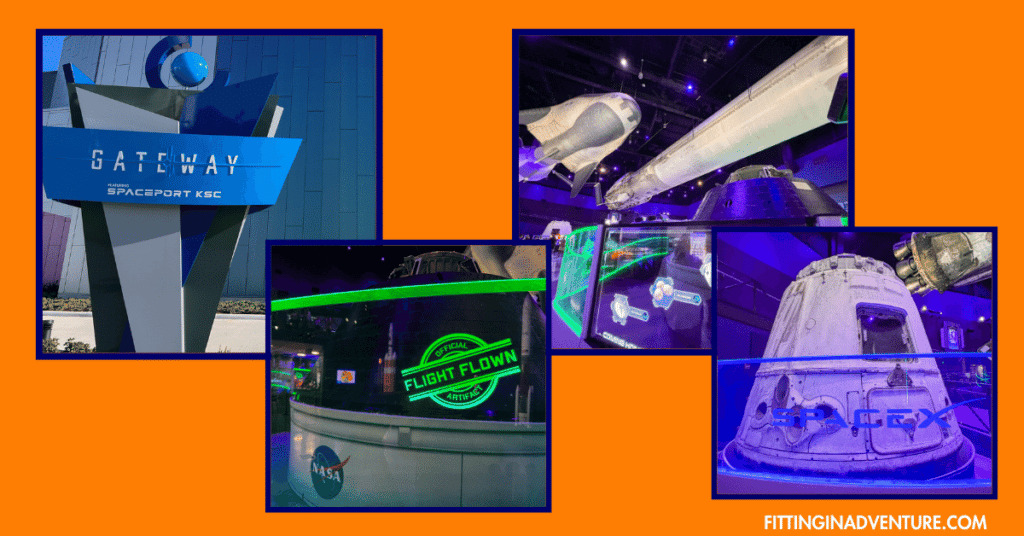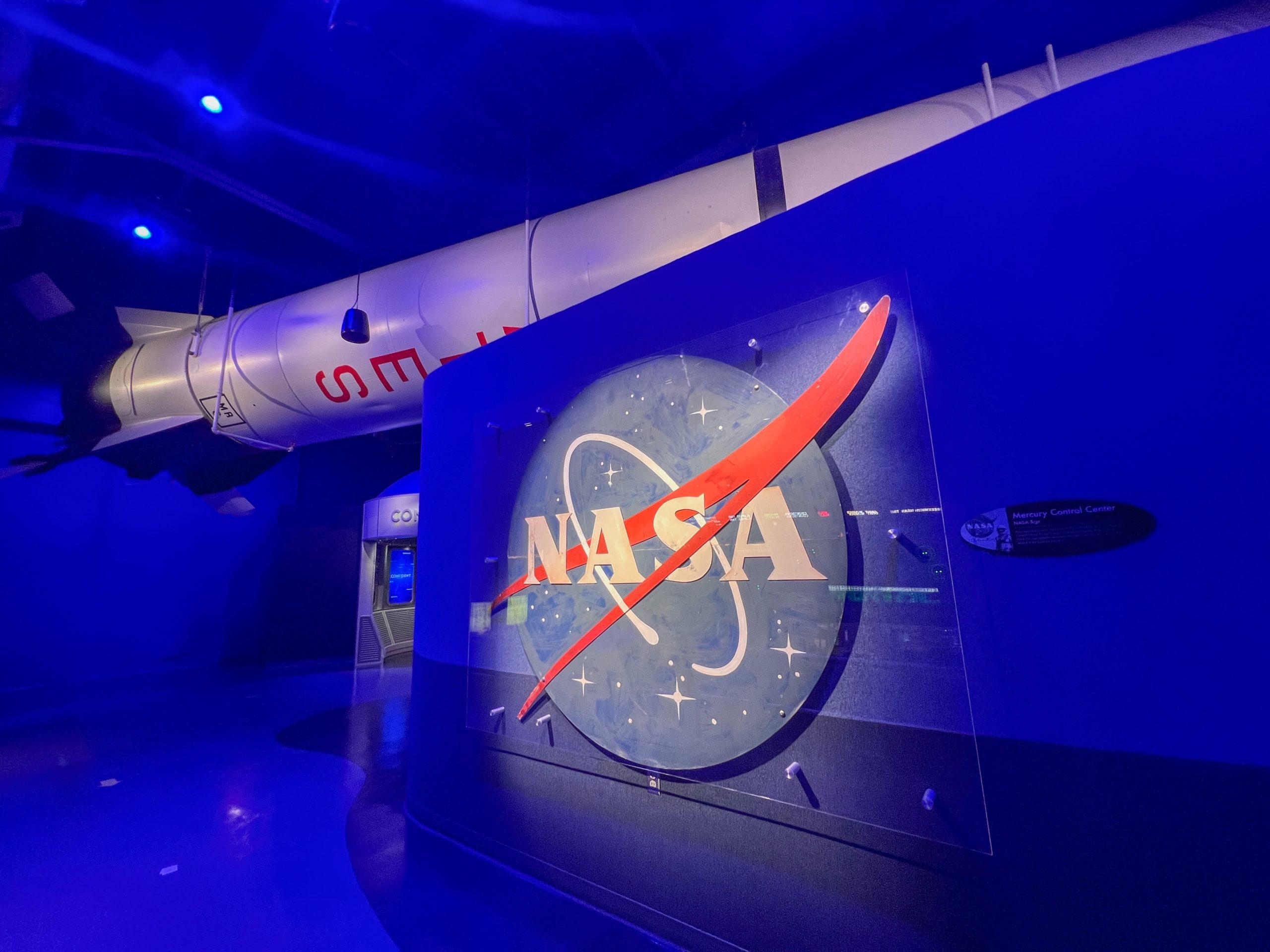Embrace or relive your childhood dreams at Kennedy Space Center. Home to space exploration’s history and future. Experience the missions and heroes of space exploration’s past, present, and future with various exhibits and a docent-led bus tour to launch pads.
Disclosure: Some links on our site are affiliate links. If you purchase a linked item, we will make a commission, at no extra charge to you.
Don’t forget to like the video and subscribe to our YouTube channel for our weekly videos.
Skip to Tips for Visiting Kennedy Space Center
Skip to FAQs for visiting Kennedy Space Center
Look Inside Gateway: Kennedy Space Center’s Deep Space Launch Complex
Opened in June 2022, you will find this exhibit just off the rocket garden and filled with current and future space travel technology from NASA and its commercial partners.
- Flight Flown SpaceX Cargo Dragon COTS-2 This was the first commercial spacecraft to deliver and return cargo to the International Space Station (ISS) in 2012.
- Flight Flown Orion Exploration Flight Test-1 (EFT-1) This Lockheed Martin capsule was first launched in 2014. Paired with the SLS rocket, the Orion will be important in the Artemis mission and returning humans to the Moon. Interactive screens allow you to compare it to the Apollo capsules.
- Flight Flown SpaceX Falcon 9 Booster Suspended above your head this booster flew twice including as a side booster to the Falcon Heavy test flight in 2018.
- Dream Chaser (Sierra Space) This reusable space plane will perform cargo resupply missions to the International Space Station. (Unit is a replica)
- Boeing CST-100 Starliner Mockup Capsule The Starliner will be capable of carrying four to five astronauts and cargo. It is designed for a ground landing rather than water. An interactive touchscreen allows you to discover more. (Mockup training capsule)
- Lockheed Martin Space Habitat This full-scale mockup allows you to “step inside” what a habitat on the Moon will look like.
- Aerojet Rocketdyne RL-10 Engine See if you have what it takes to be a rocket test engineer by “mixing the liquid hydrogen and oxygen” to certify the engine for flight.
- James Webb Space Telescope Holotube Launched in December 2021, the kiosk allows you to see its path from Earth and how its images vary from Hubble’s.

Saturn V Complex
The Apollo/Saturn V Complex highlights the race to the moon and those who got us there. Jump on a bus at the Kennedy Space Center Visitor Complex for a short 20-minute ride (you will pass the Vehicle Assembly Building too) to the Saturn V Complex. There you will find the Apollo 8 launch room, a short video, and enter to see the gigantic Saturn V. It is the largest rocket ever flown. Interactive exhibit flank the rocket giving you the opportunity to touch a moon rock and leave your footprints on the moon. Don’t miss the Ad Astra per Aspera exhibit dedicated to the lives of Apollo 1 astronauts Gus Grissom, Ed White, and Roger Chafee. The Apollo Treasures gallery offers several era artifacts and the Moon Tree Garden is descendants of tree seeds taken to the moon.
Kennedy Space Center Facts:
- Holds the fourth largest building in the world, the Vehicle Assembly Building (VAB).
- Launch Complex 39 is where the Apollo 11 moon expedition launched in 1969.
- 1.5 million people visit each year
- Every crewed NASA Space Flight since 1968 has launched from Kennedy Space Center
- Although much of the area is restricted and only 9% of the land is developed, it is one of ten major NASA field centers.
- The site is also an important wildlife sanctuary.

Space Shuttle Program Facts:
- The space shuttle was the world’s first reusable spacecraft. Launching like a rocket, orbiting like a spacecraft, and landing like a plane.
- The space shuttle system was made of three components: twin solid rocket boosters providing 80% of the launch thrust, an external tank providing fuel to the shuttle’s main engines during launch, and the orbiter providing a home for the crew during the flight.
- Crews ranged in size from five to seven people with more than 600 flying in the shuttle program missions.
- The space shuttle program sent more than 3 million pounds of cargo into space.
- The gross liftoff weight of the space shuttle was 4.5 million pounds.
- The space shuttle was 184 feet long. The orbiter was 122 feet long.
- Five shuttles flew during the program’s history: Atlantis, Challenger, Columbia, Discovery, and Endeavor.
- The remaining shuttles are now displayed for public viewing.
- Atlantis – Kennedy Space Center (Florida)
- Endeavor – California Science Center (Los Angeles, CA)
- Discovery Smithsonian’s National Air & Space Museum (VA)
- Enterprise – Intrepid Sea, Air & Space Museum (New York)
- The remaining shuttles are now displayed for public viewing.
- The Discovery, Atlantis, and Endeavor were each designed to fly 100 missions, but each flew fewer than that.

Space Shuttle Program Timeline:
- January 5, 1972 – President Nixon announced the intent to develop the space shuttle.
- March 24, 1979 – The Columbia was delivered to Kennedy Space Center.
- April 12, 1981 – NASA sent its first shuttle to space when the Columbia launched from Florida’s Kennedy Space Center.
- July 5, 1982 – The Challenger was delivered to Kennedy Space Center.
- November 9, 1983 – The Discovery was delivered to Kennedy Space Center.
- April 13, 1985 – The Atlantis was delivered to Kennedy Space Center.
- January 28, 1986 – The Challenger exploded minutes after launch due to faulty o-rings in the rocket booster. All seven crew members are killed. Flights did not resume for more than two years.
- June 27, 1995 – The Atlantis launch marked the 100th US human space launch.
- February 1, 2003 – The Columbia explodes over Texas during re-entry. All seven crew members are killed.
Tips for Your Visit to Kennedy Space Center
- Hydrate! This really goes for anything you are doing in Florida, but hydrate!
- The off-season is considered the summertime in Florida.
- Hit the Heroes & Legends exhibit when you need to cool off! The fans during the second movie offer blasts of cool air.
- Do NOT miss the Atlantis exhibit!
- Arrive early to beat the heat and (some of) the crowds. We arrived before opening and still had a long line. 1.5 million visitors a year will mean you are dealing with crowds.
- When leaving the Challenger & Columbia memorial, make a right into the room to see the shuttle pieces.
Common Questions We Received about Visiting Kennedy Space Center
- Is it worth visiting Kennedy Space Center?
- Yes! Whether you are a current space geek or simply want to relive your childhood school days of watching shuttle launches this is well worth a day on Florida’s east coast.
- Can you visit Kennedy Space Center for free?
- No, you will need a ticket to enter the area. You will also pay for parking at the park. A basic ticket will get you inside the exhibits and the bus tour.
- How many hours do you need to visit Kennedy Space Center?
- You will need a minimum of half a day, but closer to a full day to view all the exhibits and take a bus tour to the launch pads.
- Can you take a backpack inside Kennedy Space Center?
- When we visited you were allowed backpacks and water bottles. However, you should check their site for any changes to policies prior to your visit.
- Can I drive my car through Kennedy Space Center?
- No, this is a federal facility. You will park at the Kennedy Space Center Visitor Complex and be bused to other locations.

